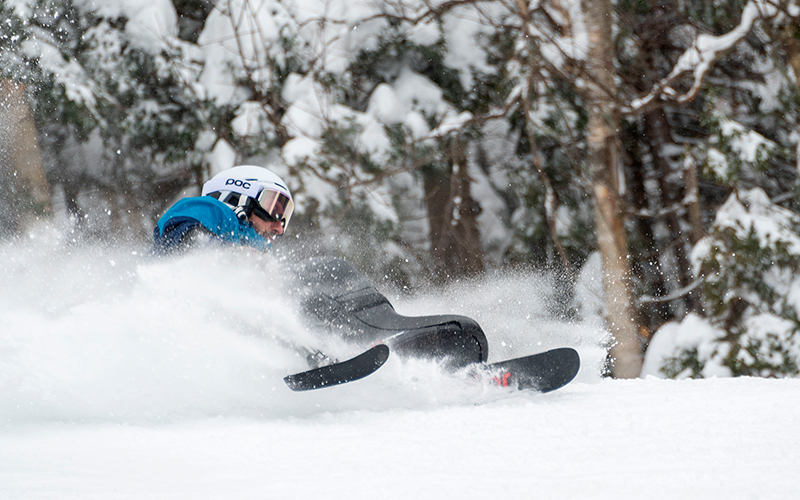Meditation. How could anyone possibly meditate while skiing at 40 mph on icy, bumpy, steep slopes?
“Stillness” is the quality one conjures of a being in a mediative state. What of the World Cup Downhill racers? These super-men and women soar through the cold air at 90 mph, flying over terrain, absorbing the rolls and depressions into their body, into their form. They even pre-jump to keep skis as close as possible to snow. It is hard to change direction in the air.
What is the meditative aspect of skiing? A good meditative state takes in all needed information, and perhaps no more. The cranial resources -- let’s use the analogy of bandwidth – are maxed out and dedicated to the moment. The moment includes the line and the mind-body connection. The meditative skill set can take years to develop and countless varieties of experience to hone and master. On a day with flat light, for example, the focus on snow texture alone demands several additional levels of enhanced focus. With reduced visual information, the feet are called upon to report conditions and the athlete needs to respond with a greater sensitivity of response.
Meditation may be said to be “a process by which an ordinarily diffused state of mind is brought into focus” (H. Guenther, Philosophy and Psychology in the Abhidharma, p122).
Ski racers are more than adept at this meditative practice, of the settling of mind before an event. In ski racing, every run is an event, including inspection. An intermediate trail that would seem easy to a recreational skier is rigorously inspected, studied, for opportunities, challenges, risks and, most of all . . speed. Rolls, depressions, and off-camber sections are memorized, and a plan of attack is formulated. This practice of focus, when applied to recreational skiing, translates to a level of awareness that may take a recreational skier many years to acquire or may never achieve in their skiing.
Fortunately, Ikon has announced that NASTAR racing is free to all skiers for the season! This opportunity is offered to recognize the phenomenal success of Mikaela Shiffrin. As of this writing, she has achieved 85 World Cup wins, surpassing Lindsey Vonn’s 83 and approaching Ingmar Stenmark’s 86. The girl is on fire!
In the last Olympic Downhill, Mikaela carried too much air off a jump and landed downhill of the line for the next gate. Mikaela, being her highly focused self, shot her hips through the length of those big DH boards and blasted herself back online. She made a slalom turn on DH boards, corrected the line and was a perfect archetype of correcting for mistakes and moving on.
How does one sharpen one’s focus? Let us assume that focus is like the bicep muscle: you can train it to greater levels of strength. How would you do this with the bicep? Pump iron, bicep curls, push-ups? Okay, what are similar exercises for building focus? With some racers, like Mikaela Shiffrin, focus seems a gift. But maybe the best skiers just learned early-on to sharpen their own tools. I saw a picture of Mikaela as a very young girl. She was at a tuning clinic and had a Swix manual in her hands. Training is both mental and physical and the best start young.
While riding the Inverness chair, I observed giant slalom training. The snow was perfect for carving: softly edge-able, without getting too rutted. Many racers were exhibiting exceptional race form. A good racer looks like a sculpture by Auguste Rodin. The energy is contained within. There is nothing but essence in the image; all excessive material has been removed.
High-level skiing and ski racing is an esoteric art form. The practitioner chooses their tools, refines their form, and learns from the best how to improvise the craft on an ever-changing tableau. The saying is that great artists “suffer” for their work. I have never heard of a Van Gogh or Bernini blowing out an ACL or breaking a bone in the B-netting. But I am losing focus here. . .
Is the next Mikaela Shiffrin out there, practicing on Inverness? They will need the level of focus that she exhibits. Focus seems like it could be a subject of study of its own accord. Focus can be applied on a slope, on a race trail, but focus can be studied off the hill. It can be identified, ramped-up and practiced. A slackline comes to mind.
Carl Jung said: “The more stubbornly we believe that all increase has to come from without, the greater becomes our inner poverty.” Focus comes from within; it is one of the underpinnings of intelligence itself.
With the temperature reaching towards 40 degrees, I felt quite comfortable changing out of ski boots outside, on the expansive new deck at Mt. Ellen. Maybe it was the bare feet, outdoors in winter that got him, but as a young teenage snowboarder walked past, he reached out his hand and I received what was possibly my first “Old Man” fist-bump? Did that just happen?












